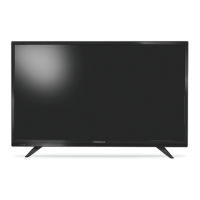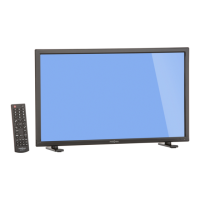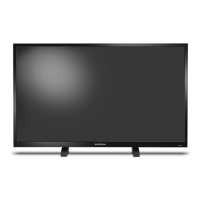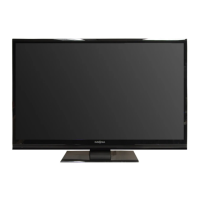How to reset parental control password on Insignia NS-32D220NA16 TV?
- Ggina20Sep 10, 2025
If you have lost the password for your Insignia TV, enter 9999 to access parental controls, then set a new password.

How to reset parental control password on Insignia NS-32D220NA16 TV?
If you have lost the password for your Insignia TV, enter 9999 to access parental controls, then set a new password.
Why is there audio noise on my Insignia TV?
If you are experiencing audio noise with your Insignia TV, other devices may be interfering with your TV.
Why is picture quality on my Insignia NS-32D220NA16 good on some channels but poor on others?
If your Insignia TV has good picture quality on some channels but poor quality on others while the sound is good, the problem may be a poor or weak signal from the broadcaster or cable TV provider. If you connect to cable without a set-top box, you may need to install one to improve signal reception and picture quality.
Why is my Insignia NS-32D220NA16 TV remote control not working?
If the Insignia TV remote control isn't working, ensure the power adapter is plugged into a working outlet. Check for obstructions between the remote and the TV's sensor. Verify that the batteries are installed correctly and that the clear plastic wrapping has been removed from the supplied batteries.
How to remove black bars on Insignia NS-32D220NA16 TV screen?
To fix black bars around the picture on your Insignia TV, press the ASPECT button to change the aspect ratio.
How to fix "No signal" error message on Insignia TV?
If your Insignia TV displays a "No signal" error message, press the INPUT button and select the correct input for your device.
How to fix no color on Insignia NS-32D220NA16 TV?
If your Insignia TV has no color, a dark picture, or incorrect colors, try another channel. Also, adjust the color settings and ensure that the video cables, antenna, or cable TV are securely connected.
How to adjust color on Insignia TV with good sound but poor color?
If your Insignia TV has good sound but poor color, adjust the contrast, color, and brightness settings.
How to fix no sound from one speaker on Insignia NS-32D220NA16?
If there is no output from one of the speakers on your Insignia TV, adjust the audio balance. Also, make sure that the audio cables are connected correctly and securely to your TV.
How to fix dotted lines on Insignia NS-32D220NA16 screen?
If dotted lines or stripes appear on your Insignia TV screen, make sure that the antenna or cable TV is connected correctly and securely. If you are using an antenna, the digital channel signal may be low. Also, ensure that the video cables are connected correctly and securely to your TV. Other devices may be interfering with your TV.
| Screen Size | 32 inches |
|---|---|
| Resolution | 1366 x 768 |
| Display Type | LED |
| Smart TV | No |
| HDMI Ports | 2 |
| USB Ports | 1 |
| Refresh Rate | 60 Hz |
| Backlight Type | Direct LED |
| Built-in Wi-Fi | No |
| Audio Output | 10W |
Guidance on safely placing your TV to prevent tip-overs and injuries.
Key safety recommendations for using the television.
Instructions and considerations for mounting the TV on a wall or ceiling.
Advice for safely relocating older CRT televisions.
Numbered safety instructions for operating and maintaining the TV.
Precautions and warnings related to the TV's glass screen.
Information on replacement parts and servicing procedures.
Details on power source operation and safety checks.
Warnings about condensation, mobile phones, disposal, and pixels.
Welcome message and overview of the Insignia TV.
Explanation of HDMI CEC technology for device connectivity.
Description of the Game mode for enhanced video game experience.
Step-by-step guide for attaching the TV stands.
Instructions for securely attaching a wall-mount bracket to the TV.
List of items included in the TV package.
Identification of components on the front of the TV.
Description and function of the physical TV control buttons.
Identification and description of ports on the side of the TV.
Identification and description of ports on the back of the TV.
Description of the remote control and its buttons.
Instructions for inserting batteries into the remote control.
Guidance on properly aiming the remote control at the TV.
Guidance on selecting the best connection type for video quality.
Steps to connect a cable or satellite box to the TV.
Instructions for connecting devices via HDMI for optimal quality.
Instructions for connecting devices via component video.
Instructions for connecting devices via AV composite video.
Instructions for connecting devices via coaxial cable.
Steps to connect an antenna or cable TV directly to the TV.
Instructions for connecting DVD or Blu-ray players.
Instructions for connecting game consoles to the TV.
Steps to connect a computer to the TV.
Guide for connecting a USB flash drive to view photos.
Instructions for connecting headphones to the TV.
Guide for connecting external speakers or a sound bar.
Steps for connecting audio devices via digital optical cable.
Instructions for connecting audio devices via analog audio jacks.
Diagram and guidance for connecting multi-device home theater systems.
Instructions for connecting the TV's AC power adapter.
Steps for installing batteries in the remote control.
Guidance on aiming the remote control for optimal signal reception.
Instructions for programming universal remote controls.
How to find and view remote control codes in the TV menu.
Guide for the initial setup wizard when turning on the TV for the first time.
How to turn the TV on, off, and into standby mode.
Steps to choose the active video input source.
General information about navigating the TV's on-screen menus.
Overview of options available in the Picture menu.
Overview of options available in the Audio menu.
Overview of options available in the Channels menu.
Overview of options available in the Settings menu.
Overview of options available in the Help menu.
Overview of the Photos menu for USB drive content.
Detailed steps for navigating TV menus using the remote.
Instructions on how to tune to specific channels.
How to increase, decrease, or mute the TV volume.
How to display program and channel information.
Explanation of INlink (HDMI CEC) for controlling connected devices.
Steps to enable or disable the INlink feature.
Setting to automatically turn off HDMI CEC devices.
Configuring the TV to turn on/off with connected HDMI CEC devices.
Controlling an audio receiver's volume with the TV remote.
How to view a list of connected HDMI CEC devices.
How to select and connect to a specific INlink device.
Guide for connecting and using a USB flash drive.
How to switch the TV to USB input mode.
Steps to browse and view photos from a USB drive.
How to view photos previously marked as favorites.
Instructions for viewing photos in a slideshow format.
General guide to adjusting TV picture quality and settings.
Description of various picture modes like Vivid, Standard, Movie.
Explanation of aspect ratio settings like Normal, Zoom, Wide, Cinema, Auto.
Overview of advanced picture settings like Overscan and Color Temperature.
Details on adjusting Backlight, Brightness, Contrast, Color, Tint, Sharpness.
How to enable automatic adjustment of picture aspect ratio.
Setting the TV's default picture mode on startup.
Guide to improving TV sound quality and resetting defaults.
Description of sound modes like Standard, Theater, Music, News, Custom.
Settings for audio output via headphones or external speakers.
How to select audio output mode for connected devices.
How to listen to TV audio with the picture turned off.
Overview of channel setting adjustments.
Steps to scan for available TV channels.
Instructions on how to hide channels from the channel list.
Guide to creating and managing a list of favorite channels.
How to access and view the favorite channel list.
How to label or relabel channels for easier identification.
How to check the digital signal strength for optimal reception.
Instructions for setting or changing the parental control password.
How to block TV programs that do not have ratings.
Guide to setting rating levels for US and Canadian content.
How to download program rating information for parental controls.
How to lock or unlock the TV's physical buttons.
Overview of closed captioning features and controls.
Steps to enable or disable closed captioning.
How to select analog closed captioning modes (CC1-CC4, Text1-Text4).
How to select digital closed captioning modes (CS1-CS6, CC1-CC4).
Guide to customizing digital closed captioning appearance.
Overview of time-related settings.
How to set the TV's clock and time zone.
How to set the TV to automatically turn off after a specified time.
How to adjust the appearance and behavior of TV menus.
How to change the on-screen menu language (English, French, Spanish).
Enabling/disabling automatic input source detection.
How to add custom labels to input sources for easier identification.
Introduction to troubleshooting and common problem areas.
How to view system information for troubleshooting purposes.
Resources for learning about TV features and connections.
Steps to update the TV's firmware for optimal performance.
How to re-run the setup wizard to customize TV settings.
How to reset all customized settings back to factory defaults.
Solutions for common video and audio playback issues.
Troubleshooting steps for a non-functional remote control.
Solutions for common general issues like no power or no channels.
Troubleshooting common problems with INlink CEC devices.
List of all available input and output ports and their specifications.
Physical dimensions and weight of the TV with and without stand.
Details about the TV's screen, including size, type, resolution, and refresh rate.
Information about the TV's analog and digital tuners.
Details on power consumption and input requirements.
Details on OSD languages, INlink, Game Mode, and VESA mount.
FCC and IC compliance statements and regulations.
Compliance information regarding radio frequency interference.
Defines warranty period and terms for Insignia Televisions.
Explains what the one-year limited warranty covers.
Instructions on how to get warranty service for the product.
Lists items and conditions not covered by the product warranty.











